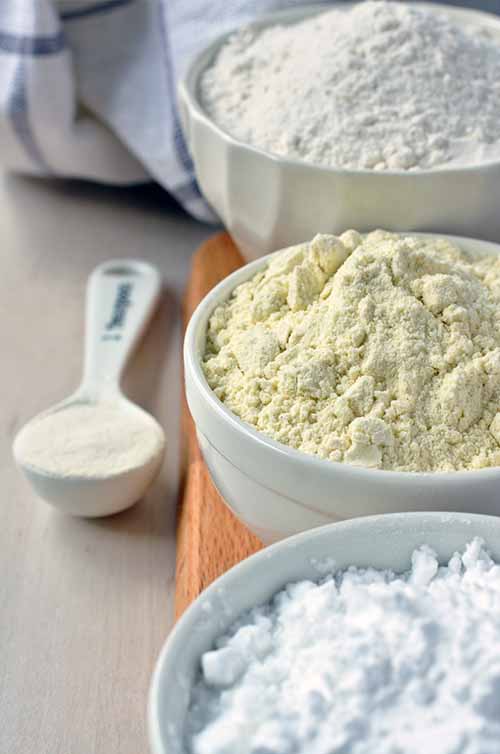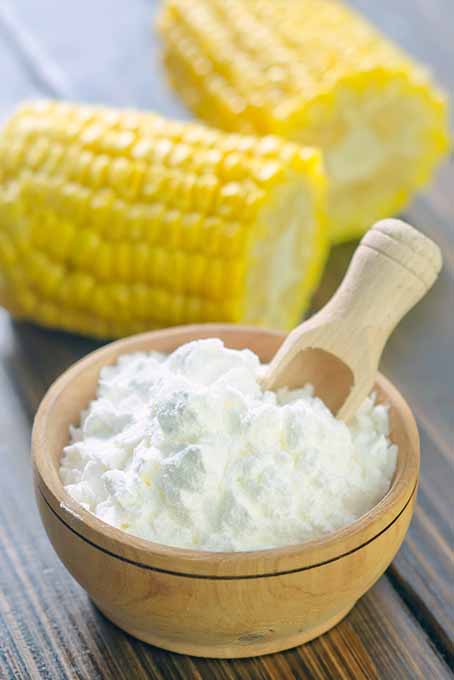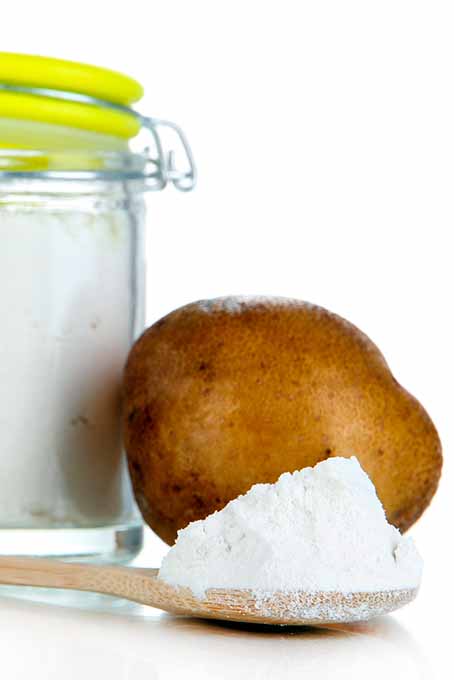Have you ever tried to thicken a dish, only to be disappointed with the results? Was it thin and runny, or perhaps it did stiffen up, only to thin out again?
As it turns out, choosing the appropriate thickener can be a dish-maker, or a dish-breaker.

Firming agents are a common addition to many recipes, from sauces and gravies to jams and jellies, to almond milk and baby formula.
So let’s have a look at the most frequently used methods for thickening soups, sauces, and gravies, their basic differences, and the most appropriate ways to use them.
Starches
For the home kitchen, the most common thickeners come from polysaccharides such as starches, vegetable gums, and pectin, and proteins like eggs and gelatin.
For sauces and gravies, starches are used. And these are usually derived from wheat, corn, potatoes, tapioca, or arrowroot.
The science of how starches work is pretty straightforward – Penn State’s online Kitchen Chemistry class gives a good explanation of the process.
When mixed with cold water, starch granules will absorb some of the liquid, but not all of it.
And if you try to give them too much all at once, they’ll gang together in clumps to repel the water – resulting in the infamous lumpy gravy. Adding water slowly helps to absorb more liquid, but the key to their thickening properties is heat.
Heat breaks down the weak spots in the granules, creating more room for the water to be absorbed. And once this happens, the agitated molecules form a network as they join together. This process is known as gelatinization, and it’s when your sauce begins to stiffen.

Cornstarch – is made from corn, and has twice the thickening power of flour.
It excels in firming up gravies and sauces, like the delectable sweet and sour sauce for this stir-fried shrimp dish.
Because of its transparent qualities, cornstarch is ideal for use with fruits as it allows their rich, vivid hues to shine through. Fruit fillings benefit from thickening with this type of starch as well as other desserts, like this homemade German vanilla pudding.
However, acidic ingredients such as lemon juice or vinegar can inhibit the thickening properties of cornstarch (and flour), preventing gelatinization.
Flour – Wheat flour is comprised of starch and proteins.
It’s a good thickening agent for sauces, stews, gumbos, gravies, and fruit fillings, as it imparts a smooth, velvety mouthfeel.
It also works very well when it’s mixed with a fat, making it ideal for creating a roux or beurre manié – more on those a little later.
When added to a sauce, it will become opaque. And, if cooked for too long, it may thin out again.

Potato starch – Gluten free, potato starch is all starch.
It can be used for stiffening gravies and soups, as well as baking. It’s also the starch of choice for Passover cooking.
When using potato starch, avoid boiling, which will reduce its gelatinous properties.
Arrowroot & Tapioca – Both starches are obtained from the rhizomes of South American plants.
Less commonly used than the others listed above, these are gluten free, won’t cause cloudiness, and work well with acidic ingredients.
Tapioca makes an excellent thickener for strawberry rhubarb pie, or this red berry pudding.
Thickening Methods
Whitewash
A flour whitewash is created by whisking together flour and cold water. Once the mixture is well blended and smooth, it’s added to a simmering liquid and cooked for several minutes to remove the raw, pasty taste of the flour.
Not sure which type of whisk is best for the job? Check out Foodal’s review of the best whisks for your kitchen.
Slurry
A cornstarch slurry is similar to a whitewash, except cornstarch is used instead of flour. The cornstarch needs to be dissolved in water so that no lumps remain, then added to the ingredients that are being cooked. Simmer for a couple of minutes until no starchy flavor remains.
A flat whisk, also known as a roux whisk, is an excellent selection for making thickened sauce bases and gravies. We recommend investing in this Cuisipro model available at Amazon.
Roux
You may not be familiar with the term, but you probably know the method – it’s the basic white sauce used for making a batch of homemade mac and cheese, like this one or this one. Or you might use it as the base for pan-drippings gravy.
A roux is created by mixing equal parts flour and fat, such as butter or pan drippings, and cooking over medium-low heat until it reaches a stiff, smooth texture.
When done, a roux has a rich, silky body and a light nutty flavor – which increases the longer it’s cooked. But, the longer it cooks, the less thickening power it will have as the gelatinization breaks down.
Roux can be made with vegetable oils, but they do have more of a tendency to separate. Clarified butter and rendered fat drippings are better mediums, as the flour will be suspended in the fat when it cools. And this cohesion will prevent lumps, when it’s mixed in with sauces or soups.
As soon as the flour is whisked into the hot liquid, it will stiffen into a rough paste. But at this point it will have a grainy texture and a raw, floury taste.

Simmering for 5 to 45 minutes over medium-low heat will soften the flour as it absorbs the liquid, cooking away the raw taste, and developing a toasty fragrance and flavor as it caramelizes.
Constant whisking is required when making a roux, to ensure that it doesn’t burn or separate.
- A white roux remains an off-white color, and is cooked only until the raw, starchy taste and fragrance is removed, for about 5 to 10 minutes. It will still have a slightly gritty texture, but will be much smoother than it was at the start.
- Used for cream soups, chowders, and white sauces.
- A blond roux is cooked a bit longer until lightly caramelized, approximately 15 to 20 minutes. It will now have a much silkier texture, and a light fragrance with a flavor reminiscent of toasted nuts.
- Used in pureed soups and meat sauces, or when a deeper flavor is required.
- A brown roux is cooked even longer until highly caramelized for 40 to 45 minutes, which results in a rich, nutty flavor and a caramel color.
- Used in brown sauces, gumbo, stews, sausage gravy, and dishes where a darker color is desired.
Beurre Manié
French for kneaded butter, this is a combination of equal parts flour and softened butter. Simply use your fingers to rub the two together until the consistency is that of a dense paste, and small rounds can be formed.
The rounds are then whisked into a sauce, chowder, or stew to finish a dish. When the butter melts, the flour is dispersed evenly without creating any lumps, adding shine to dishes and a lustrous, satiny mouthfeel.

A coiled whisk is perfect for stirring together sauces and preventing lumps from forming. Foodal recommends this model from OXO, available on Amazon.
Conclusion
Now that you know the basic differences between thickening agents, will it change the way you make your sauces and gravies?
Or, if you’re already skilled in this area, do you have any tips to share?
Let us know your thoughts and opinions in the comments below.
Photo credits: Shutterstock, Cuispro, and Kuhn Rikon.
About Lorna Kring
Recently retired as a costume specialist in the TV and film industry, Lorna now enjoys blogging on contemporary lifestyle themes. A bit daft about the garden, she’s particularly obsessed with organic tomatoes and herbs, and delights in breaking bread with family and friends.




Oh, I’ve been looking for a post like this! I’ve been struggling to make a (thick but not too thick) pancake but it always comes out too thin and therefore, a bit flavorless. I will be using this article next time I go grocery shopping to make sure the pancake turns out perfect. You’re a life saver, thanks!
Glad you found the post helpful Canary. And best wishes for that perfect pancake!
Thank you very much! I will be going shopping tomorrow and I’ve already made a list of flour and starches to buy. I can’t wait.
I usually don’t make sauces at all. Although when I make pancakes sometimes I accidentally add too much water. Then I simply add more of the pancake mix to even things out. This is a great post to refer to if I wanted to know what type of thickener I should use for different dishes.
A handy reference for when you do need it Jasmine – thanks for your comments.
Thank you for this article. I’ve always flour as a thickener and I don’t think it ever occurred to me to try anything else. It’s always been a bit of a problem with some dishes, and there are a few fruit dishes I might try again with cornstarch.
Does lemon juice affect most stiffeners poorly? I have a cream and gelatin dessert recipe for mousse that works with strawberries, but not lemons, and that might explain it.
For starches, both arrowroot and tapioca will work with lemon juice katie. I’m not sure if it’s the problem with your cream and gelatin, but there are enzymes in fruits like pineapple, kiwi, guava, and papaya that prevent gelatin from setting.
I never really stopped to think about there being other choices. I generally just use cornstarch to thicken.
I have used instant mashed potato flakes in stuff like potato soup, but I never realized there were other options.
This is interesting and helpful. I’ll have to keep these other methods in mind.
Cornstarch is pretty reliable Zyni, but it’s nice to know there are other options too! Glad you found the post helpful.
There are two thickening agents that I use for my gravies and stews that add’s flavor AND nutritious minerals that I am a little surprised were not mentioned here. I grind up either Chia Seeds or Flax Seeds into a flour and use those. They add great flavor to many dishes and they act as a great thickener. I have also read that to gain the full benefits of these two nutritious seeds, it is best to grind them up anyway so that your body can absorb them. Whole, they just pass through your body because (just like corn) your body can not fully digest them.
Ground seed meal is certainly an option to add body and flavor toradrake, but they don’t fall into the starch category so didn’t get a mention here. Thanks for your comments.
Thank you so much for the interesting post, I’ve always used cornstarch, flour or potato starch to thicken my sauces but I wasn’t aware of most of the specifics. Just to make an example, a few days ago I tried to thicken a balsamic vinegar based sauce with cornstarch without success and now I know why thanks to you. I had no idea acidic ingredients could inhibit the thickening properties of cornstarch, I’m definitely keeping it in mind for the next time!
I’m also going to follow your precious tips next time I’ll make roux.
That’s great that you found the reason for your vinegar-based sauce not gelling Snarya! And have fun with your roux making…
Thanks for the additional ideas! I use flour usually and cornstarch when I want to be sure to not be lumpy. I also never realized that heat helps! I try to mix a bit of water with my flour or cornstarch first and usually have to whisk the heck out of them. Tonight’s gravy, I’ll be sure to turn up the heat. Love love love the idea of the softened butter and flour mixed together. That would make things so much easier. Let me ask, I’m assuming that’s something that could be made in a big batch and frozen, yes?
Heat’s the key (or one of them) Mrs. Fitz! And yes, the little flour and butter balls freeze up well and are very convenient to have on hand.
I have always used flour for thickening my sauces, soups, stews etc. I didn’t know of the other methods for specific liquids while cooking. I have ran into a few problems with flour , typically clumping is my main issue and I sometimes find it difficult to get rid of the flour smell. This is so refreshing because I can utilize these methods and actually have my sauces and such turn out even better. I’m going to make a gravy to go over my steak tonight using one of these methods. Can’t wait!
A little science solves a lot of cooking issues faye, glad you found the info helpful. And enjoy your gravy!
Flour or cornstarch have always been used as the preferred thickeners in my home. Instead of mixing them with water before adding to the sauce or gravy, we always mix it in a little cup of the sauce or gravy it will be added to. When it’s smooth, dump it in with the rest of the batch, and whisk until smooth. I just feel that adding water will take away from the taste and make thickening it take longer, since more liquid is being added. I’ll have to finally break down and get some arrowroot or tapioca starch since they work well with acidic ingredients. I’ve always been hesitant to buy them if a recipe calls for them, subbing in the cornstarch I have on hand instead. Now that I know they work better than flour or cornstarch with acids, I’ll have to buy some, as I love acidic fruits and vinegars.
Thanks for your sauce making tips lebrennan, and enjoy the results you’ll get using arrowroot and tapioca for acidic sauces!
Really good discussion of the difference in the chemistries of the different thickening agents. I generally just used the rule that if I wanted it to be cloudy, use flour, if I wanted it to be clear and show the color, use cornstarch. I was never aware of the problem with acidic foods, so it is good to know there is a better option there. I guess that is why some of my lemon sauces for chicken dishes never looked good. Great post!
Acidic ingredients like lemons add so much to dishes, it’s a shame when they don’t turn out as planned… Glad you enjoyed the post Azril!
I tend to use flour most of the time, since I always have it on hand and it works great. I notice its easier to incorporate the flour as needed, whereas with the cornstarch, if you put too much on accident, it’ll end up super thick.
Flour is nice and easy ashley, but cornstarch for berries and pies is so darned pretty, it’s worth the effort to get it right!
Flour works too, but in some things better than others. I always use it for cream gravy, such as for biscuits or pork chops. I still mostly reach for the cornstarch for thinner stuff like the gravy I make with a pot roast or something. I also tend to use it for desserts.
I would really like to have one of those coiled whisks. I’ve been looking for that thing. I thought I remembered seeing it on here somewhere. 🙂
Good points on the different textures Zyni, thanks for sharing. Let me think about that coil whisk a bit…
What thickener can I use for my Eastern N.C. style BBQ sauce? We love the taste and color, just not the consistency. Other ingredients are brown sugar and honey.
I have used cornstarch over the years in my lemon pies and it worked well. We have now started to be as organic as possible but so far the two brands of organic corn starch I’ve used just doesn’t do the job. Any suggestions?